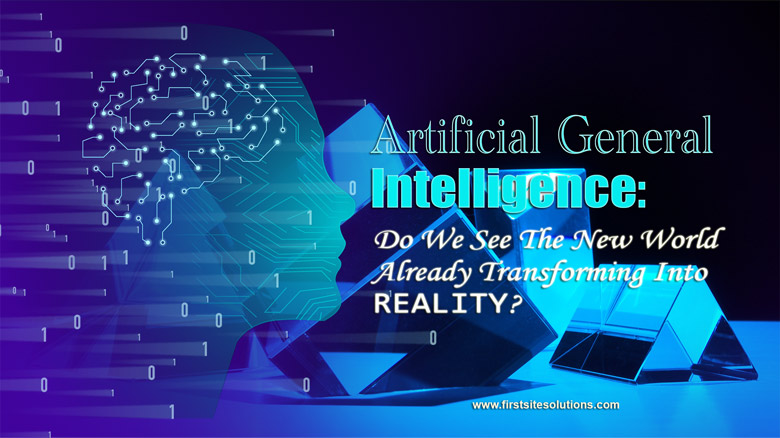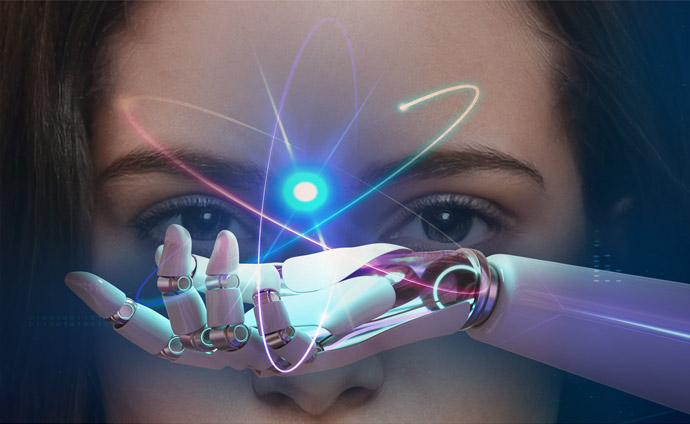
Right now, there is a whole body of researchers debating the extent to which artificial general intelligence could mimic the human brain. Digital life continues to augment human capacities and disrupt eons-old human activities. And as the increasing algorithm-based artificial intelligence (AI) continues to spread, we are bound to question:
Are we witnessing the new world order already?
There are examples of AI everywhere we look. However, Artificial General Intelligence is still in its primary stages. Let us have a quick refresher first.
What is Artificial Intelligence (AI)?
In simpler terms, AI is software made to perform specific tasks. It doesn’t have a consciousness or soul. Our day-to-day experience with AI is quite vast. Think about ordering Alexa to switch off your room lights and facial recognition on Facebook. Take the fraud detection used by banks or self-adjusting Nest thermostat to keep your home at a comfortable temperature.
Hence, Artificial Intelligence (AI) comes in several shapes and forms.
A few other examples of Artificial Intelligence (AI) include:
- Spam filters on email
- Prediction tools and disease mapping
- Manufacturing and drone robots
- TV show recommendations from Netflix
- Social media monitoring tools
- Robot advisors for stock trading
What is Artificial General Intelligence (AGI)?
Artificial General Intelligence (AGI) is the representation of general human cognitive abilities in the software. If the system faces an uncertain task, the AI system can find a solution.
In layman terms, AGI is the kind of artificial intelligence we see in the movies. Such systems can perform tasks with greater efficiency than humans. Nonetheless, they have zero capability to perform a task that they are not trained to do—for instance, robots from Star Trek: The Next Generation or Westworld.
Artificial General Intelligence is also known as deep AI or strong AI. It is a concept of a machine that can think, understand, learn, and apply its intelligence to solve different problems. Strong AI involves training machines to understand humans to differentiate emotions, needs, beliefs, and thought procedures.
Although it sounds appealing, achieving such a level of perfection is not an easy feat.
For example, Fujitsu-built K constructed one of the fastest supercomputers. It was a notable attempt to achieve a robust AI system. The system took 40 minutes to simulate a single second of neural activity. This makes it clear that strong AI is quite challenging to achieve soon.
What Capabilities Can Turn AI into AGI?
Achieving complete human intelligence is complex and daunting. It is worthwhile to look at some of the capabilities that AGI needs to master:
Fine motor skills
We take the act of retrieving keys from our pockets for granted. Researchers in the AGI field are working on this function. Barely a few would let humanoid hands complete this task for us. A recent demonstration showed how reinforcement learning could teach a robot hand to solve the Rubik’s cube. This demonstration shows the dexterity involved in structuring robot fingers to accomplish a complex task.
Sensory perception
Deep learning has opened several avenues in computer vision. But the AI systems are far from developing human-like sensory capacities. For instance, the systems that are trained via deep learning have poor color consistency. So much that self-driving cars have been fooled by small pieces of black tape on a red stop sign.
This is because the current computer vision systems are hugely incapable of extracting three-dimensional information from static images.
Along with this, humans can determine the spatial characteristics of an environment from the sound when they are listening to a monaural telephone channel. We can easily understand the background noise and create a mental picture of where someone is when speaking to them on the call. So far, AI systems can’t replicate this distinct human perception.
Natural language and understanding
Humans record and transfer knowledge and skills via books, blog posts, articles, and many more resources. AI must consume all of these resources to consume information with thorough comprehension. Humans write with an assumption of the reader’s general knowledge. That is why a vast amount of info remains unsaid. AI cannot operate in the real world because it lacks basic common sense.
Douglas Hofstadter rightfully notes that deep learning does not mean that AI is close to general reading comprehension. In fact, it has no understanding of context over multiple sentences, which even toddlers can handle effortlessly.
Creativity
Advocates of Strong AI theorize that once AI reaches human-level intelligence, it will improve itself a bootstrapping process to reach levels of intelligence exceeding those of humans. Yet, to accomplish this self-improvement, AI has to rewrite its own code. This level of introspection requires the AI system to understand the vast amount of code that humans cobble together. It will also identify novel methods for improving it.
Machines have displayed the ability to create photos and compose music. But later advances are required for human-level creativity.
Problem solving
In all available apps, a robot has to diagnose the problem and then address those. A home robot will recognize that the light bulb is blown and needs a fix. The robot needs some level of common sense to accomplish these tasks.
Today, no systems process this level of common sense or a general-purpose simulation capacity.
Social and emotional engagement
Humans must interact with the robots and AI interfaces to make it a successful development. The robot will need to understand the humans and analyze their emotions. It will require skills to read facial expressions and note changes in the vocal tone that reveals underlying feelings.
Some limited uses are already working. For example, contact centers can detect when a customer sounds angry or worried. It directs them to a specific department according to their tone.
However, we must remember how humans themselves have not mastered the skills of interpreting emotions. AI that can empathize is a far-fetched concept.
What are the Requirements of Artificial General Intelligence (AGI)?
To define artificial intelligence is a daunting task. For a vivid understanding, keep in mind that there are several traits that AGI systems should have, as you see in all humans.
- Transfer learning skill
- Background knowledge
- Common sense
- Causality
- Abstraction
Although Advanced, AGI Will Always Require Human Assistance. Why?

People generally categorize today’s computers as intelligent because they can learn and decide as per the info they consume. But this intelligence is different than the cognitive abilities that humans possess.
According to Alan Turing’s philosophy, AI imitates how humans feel, speak, and act. This level of intelligence is instrumental in an organizational setting. It can swiftly identify informational patterns that align with trends relevant to a job. The best part is, AGI never gets tired like us humans do.
AGI is ideally suited to perform lower-level routine tasks repetitively and happen in an enclosed management system. As a case in point, the assembly line at Amazon places algorithms as managers to supervise human workers. It can even fire them based on poor performance reviews.
On the flip side, humans can imagine, feel, anticipate, and determine the changing situations. This enables them to shift from short-term to long-term concerns. Such skills are unique to humans and do not require a steady input of external data to function. Thus, humans represent authentic intelligence.
For this reason, prodigies exploring AI and AGI believe that it will be a combo of both talents, human and artificial, working in tandem. It will create the kind of intelligent stream which is creative and proactive.
AGI Brings an End to Human Domination
The use of General AI can take a horrific turn at any point. Not in a sense where you delete all photos of your child during the iOS upgrade. Instead, it can go to the extent of killing the entire human civilization.
Here are the following two scenarios to explain how it could happen:
Scenario # 1: Super intelligence
Humans have eventually grown around the concept of being the most intelligent species in the world.
Ask yourself, what would happen if we come across twice- or thrice species as intelligent as us? What if this new creation perceives humans the same way we do ants and other insects? Would it go for the eradication of human beings in the best interest of the planet?
This may seem absurd and far-fetched. But, this is the road we are heading on with General AI. One primary trait of General AI is that it learns and evolves. The human evolution that typically happens every 20 years is relatively slow compared to AGI, where evolution occurs within moments.
After a month of evolution in a system, it could have surpassed the entire evolutionary process of life on Earth. The abilities of a system can go beyond imagination, and it could end up working more than human comprehension. Overnight, this can flip our position as the top scorer of the intellectual food chain.
Thus, it is vital to ask relevant questions when developing General AI. We should consider all odd before diving into the development and advancement of AGI.
Scenario # 2: Humans do evil things
Technology and tools, when used for the wrong reasons, can spell disaster. For example, smelting metal from the bronze age enables us to create new farming tools. Simultaneously, it also helped entities to make swords and weapons to kill each other.
Moreover, the Internet-connected societies and communities. Alongside, it also enabled terrorists and trolls to use it for malicious reasons.
The same goes for General AI.
Communities can use it to solve the problems faced by societies. Some corrupt minds can also deploy AGI as a cyber weapon. This becomes a means of monitoring, controlling, and influencing society. It can be used to overthrow a nation, plan an economic crisis, and even lead to a military invasion.
It would be plausible to state that the next arms race is to create the first efficient General AI. The first nation that makes the best AGI structure can become the next superpower (perhaps the last superpower).
The worst part – the use of General AI is subtler than the use of nuclear weapons. Nuclear weapons are used in anger, but the use of AGI to influence society or politicians is almost invisible. Despite all the agreements they make, the concealed use of AGI can destroy the entire human race without leaving a trace of its initiation.
How to Stay Ahead in the Race?
The best way to counter this hype about AGI is to take tangible actions. These will aim to monitor developments and place your organization/nation to respond appropriately to the progress in this field. Here is a checklist of all the actions you can take:
- Stay well-informed – Connect with startups and develop a framework for tracing and tracking the progress of AGI developments. Also, consider the right conditions, governance, and boundaries required for success in your venture.
- Recreate environments – Several steps can be taken to adjust with landscape and amplify the uptake. This covers simplifying procedures, making physical spaces, and changing analog systems into digital. It can smooth the transition towards AGI for the entire community and stakeholders.
- Democratize technology – The pace towards tech should always be steady and firm. It includes creating technologies beyond IT, selectively using platforms that ask for little or no coding skills.
- Invest in combined human-machine interfaces – This category covers everything from analytics to human decision-making. Using tech to help people become more productive has been the fuel of economic progress. It will remain the same in the foreseeable future.
AGI may not be all set to use in this century. Nonetheless, some capabilities may start appearing in some of the unexpected places. Only those well-prepared can make the most out of these perks.
Conclusion
Artificial Intelligence requires a couple of decades to reach the level of AGI. The transition is in its initial stages, and most communities incorporate it into their systems to make the most out of current opportunities.
Without a doubt, AGI is the future and beginning of an exciting career in many fields. We better prep all gear needed to leap into it!








